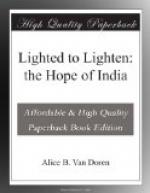[Illustration: BIOLOGY CLASS AT LUCKNOW COLLEGE Head of Class Leaning on Table, and Nine Students Dissecting Nine Rabbits]
LUCKNOW
Lal Bagh.
A dusty journey of a night and almost a day brings you from Calcutta across the limitless Ganges plains to Lucknow, capital of the ancient kingdom of Oudh. Every tourist visits it, making a pious pilgrimage first to the Residency, where in the midst of green lawns and banyan trees the scarred ruins tell of the unforgettable Mutiny days of ’57; and then to the nearby cemetery, where the dead sleep among the jasmines. Then, if his hours are wisely chosen, the traveler drives back to the town at sunset when palace towers and cupolas, mosque minarets and domes are silhouetted against the blazing west in an unrivalled skyline.
The tourist returns to the bazaars and in the midst of them, amid the dust and clatter of ekkas and tongas, probably passes by a sight more interesting than Residency ruins and abandoned palaces—inasmuch as it deals with the living present rather than the dead past. It was in Lal Bagh, the Ruby Garden of hid treasure, that the Nawab Iq bal-ud-dowler, Lord Chamberlain to the first king of Oudh, hid, according to report, great caskets of silver rupees, with a huge ruby possessed of magic virtues, and left behind him a sheet of detailed directions for finding the treasure, with, alas, a postscript to explain that all the careful directions were quite wrong, being intended to mislead the would-be discoverer. It was again in Lal Bagh that Isabella Thoburn founded her school for Indian girls, and in 1886 opened the classes of the first women’s college for India to possess residence accommodation and a staff of women teachers. The buried rupees and the magic ruby have never been unearthed; instead these years of Lal Bagh history have witnessed the discovery of richer treasure in the minds and hearts of young women, set free from age-long repressions and sent out to share their riches with a world in need.
You enter Lal Bagh’s gates and find yourself before a stretch of dull red buildings whose wide-arched verandahs are built to keep out the fierce suns of May In November the sun has lost its terrors, and you rejoice in its warmth as it shines upon the gardens with their riot of color—yellow and white chrysanthemums, roses, and masses of flaming poinsettias, surely a fair setting for the girls who walk amid its changing loveliness.
Cosmopolitan Atmosphere.
As you leave the setting and for a few days merge yourself into the life that is going on within, there are a few outstanding impressions that fasten upon you and persistently mingle with Lal Bagh memories. Of these, perhaps, the foremost is the cosmopolitan atmosphere. Here you have on the one hand a group of American college women representing no one locality, no narrow section of American life, but drawn from east and west, north and south. On the other side, you see a body of nearly sixty Indian students whose homes range all the way from Ceylon to the Northwest frontier, from Singapore to Bombay.




